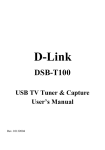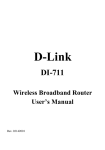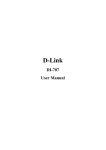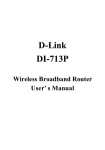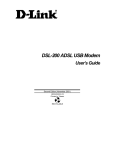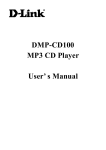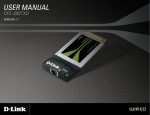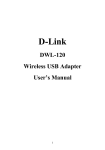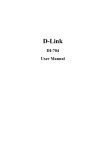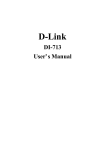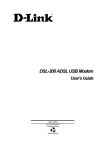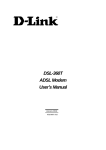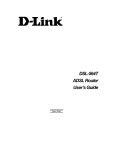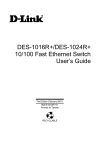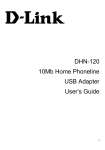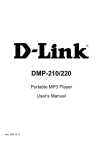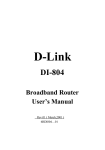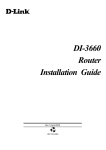Download D-Link DFE-690TXD User's Manual
Transcript
DFE-690TXD Cardbus PC card User’s Manual Rev. 01 (July, 2001) CONTENTS Introduction................................................................ 1 General Description ................................................................... 1 Contents of Package ................................................. 3 About Fast Ethernet .................................................. 4 About Autonegotiation.............................................. 5 LED Indicators ........................................................... 8 Summary of Features ................................................ 9 Troubleshooting ........................................................ 11 Confirming the Connection (LED Indicator)............................... 11 Troubleshooting the Hardware Installation ................................ 12 Verify Each Computers Identification......................................... 12 Verify Network Adapter Installation............................................ 12 Verify Cable Connections .......................................................... 13 Diagnostics and Checking Communications ............................. 14 Pinging your DFE-690TXD Card ............................................... 15 Networking Basics .................................................... 17 Computer Identification .............................................................. 18 Sharing Files .............................................................................. 20 Sharing Printers ......................................................................... 25 How to Install TCP/IP................................................................. 29 Configuring a Dynamic IP Address............................................ 31 Configuring a Static IP Address................................................. 34 Checking the TCP/IP Address ................................................... 37 Checking the Connection by Pinging......................................... 39 D-Link Offices Worldwide ......................................... 41 Specifications ............................................................ 43 Contacting Technical Support.................................. 46 FCC Statement........................................................... 47 Limited Warranty ....................................................... 49 Registration................................................................ 53 ii Introduction Thank you for choosing D-Link DFE-690TXD, the value leader among Ethernet/Fast Ethernet adapters for notebook PCs. This chapter provides a general description of DFE-690TXD features, with a summary of features at the end of the chapter. Installation instructions are given in Chapters 2 and 3. General Description The D-Link DFE-690TXD Cardbus PC Card for notebook PCs is a credit-card sized Ethernet / Fast-Ethernet adapter for connecting a notebook PC to an Ethernet network. The notebook PC must be equipped with either a PCMCIA (16 bit) extension bus or it must be Type II Cardbus slot(s) compliant. NOTE: The terms "PC Card" is used throughout this manual to refer to those objects as defined in the PCMCIA / PC Card standards published by Personal Computer Memory Card Industry Association (PCMCIA). The term “slot,” as used in this manual, is synonymous with “socket” where the standards use the latter term in reference to the physical receptacles of a host notebook computer, for insertion/connection of PC Cards. More information on the standards is available from PCMCIA’s www server at http://www.pc-card.com. 1 The D-Link DFE-690TXD automatically detects the parameters of its Ethernet environment, and automatically negotiates and determines its own speed and duplex settings as required for maximum performance within the environment. (The autonegotiation function is effective only when the DFE-690TXD is connected to the network by a device (switch or hub) which also has autonegotiation functionality.) Inside its compact case, the D-Link DFE-690TXD holds an Ethernet controller, network processing interface, a 68-pin PC Card Standard front-end plug, which connects to the notebook PC, and a direct port for connecting RJ-45. The DFE-690TXD requires no pre-installation setup -simply insert its front end into the notebook PC's PC-Card slot. The DFE-690TXD is supplied with an RJ-45 receptacle, which receives the network cable. The direct port features full LED display for Link/ACT and speed. 2 Contents of Package DFE-690TXD Cardbus PC Card A One DFE-690TXD Cardbus PC Card B Driver CD C User’s Manual in CD-ROM D Quick Install Guide E One case holder for the DFE-690TXD 3 About Fast Ethernet Fast Ethernet is a network technology specified by IEEE Standard 802.3u. It extends the traditional 10Mbps (10 megabit/sec) Ethernet technology to achieve 100Mbps (100 megabit/sec) transmission and reception. Because Fast Ethernet retains the traditional Ethernet CSMA/CD (Carrier Sense, Multiple Access, Collision Detect) protocol, it remains wholly compatible with 10Mbps Ethernet while providing a tenfold increase in network capacity. The Fast Ethernet standard specifies three subtypes, corresponding to three media types: • 100Base-TX (using two twisted pairs in EIA 568 Category 5 UTP or STP cable) • 100Base-T4 (using four twisted pairs in a Category 3, Category 4, or Category 5 UTP cable) • 100Base-FX (using two fiber-optic strands). The DFE-690TXD provides full-duplex and half-duplex 100Base-TX operation (in Category 5 twisted-pair cable environments). It does not provide 100Base-T4 or 100Base-FX operation. To provide for traditional 10Mbps Ethernet operation in twisted-pair cable environments, the DFE690TXD also offers 10Mbps Ethernet operation, in full-duplex and halfduplex modes. The DFE-690TXD's autonegotiation capability provides for automatic selection of the best operation mode. 4 About Autonegotiation The basic idea of auto-negotiation can be understood by reflecting for a moment on the familiar process of making a dialup connection between two modems. You have probably heard some exchanges between your local modem and a modem at the other end of a telephone line. (These exchanges are ordinarily played out through a speaker in your local modem). As irritating as those few seconds of noise may be, they do let you know that your modem and the remote modem are on the job, preparing for your intended communication with the remote computer. The preparatory work of the two modems during those few seconds before you see the “connect” message is to negotiate the best data communication scheme which is supported by both modems, and which is suitable for the quality of the telephone-line connection between them. The parameters to be settled between the two modems include best baud rate, compression method, and error correction method. When the two modems have tested the phone-line quality and have switched to the combination of parameters which will provide the best data communication, then you are given the “ connect” message which signals the end of the inter-modem negotiation and the beginning of your intended communication with the remote computer. Autonegotiation between devices within an Ethernet LAN is similar in 5 concept, but much briefer. The two devices involved in the autonegotiation will be your DFE-690TXD and the switch or hub through which it is connected into the LAN. (Switches ordinarily provide for autonegotiation; traditional hubs do not.) The parameters to be negotiated between the DFE-690TXD and its supporting switch or hub include speed (100Mbps = Fast Ethernet, or 10Mbps = traditional Ethernet) and duplex mode (half-duplex or full-duplex). Startup communication between the two devices occurs when both devices are operating, the cable connection between them is good, and the connected notebook PC's network software is loaded. As soon as those conditions are satisfied, the preparatory process of auto-negotiation between the DFE-690TXD and its supporting device begins and proceeds automatically. If the supporting switch or hub has autonegotiation functionality, then it and the DFE-690TXD exchange a series of messages in which each device signals its capabilities and listens for corresponding information about the other. The auto-negotiation process requires only a few milliseconds, and the two devices select the best communication parameters supported by both devices. If the supporting device does not have autonegotiation functionality, then its monotone (single capability) message will be recognized by the DFE690TXD’s autonegotiation facility, and the DFE-690TXD will simply switch to the one of its own capabilities which matches that of the 6 supporting device. Once the auto-negotiation is completed, the line is ready, and it will provide an optimal data channel between the DFE-690TXD and the supporting device. The line will remain ready without further autonegotiation action until the link is broken. Auto-negotiation then reoccurs at any time that the link is restored, again making the line ready for optimal data communications. 7 LED Indicators The direct port features 2 LED indicators: 100 Indicator: indicates that data transmittal rate is at a fast 100 Mbps. 10 Indicator: indicates that data transmittal rate is at 10 Mbps. 8 Summary of Features Features of Model DFE-690TXD Cardbus PC Card: • 100Mbps and 10Mbps data rates in compliance with IEEE 802.3 • Ethernet standards 100Base-TX and 10Base-T • PCMCIA PC Card Standard Ver.2.0 and newer • PCMCIA standard 68-pin front-end connector • 15-pin back-end connector for media coupler • Full-Duplex capable in 10Mbps and 100Mbps modes. • Autonegotiation per IEEE 802.3u specification • No manual setup switches –– fully automatic configuration • Supersonic waves-welded stainless steel case • RJ-45 connector with auto-detection of network speed • Software support: Diagnostic Program LANtastic Bayan VINES Pathworks PC LAN support program 9 LAN Manager Windows 95 Windows 95 OSR2 Windows 98 Windows 98 SE Windows ME Windows 2000 Windows XP Personal NetWare NetWare ODI Client 3.X, 4.X NetWare 4.1, Client 32 NCSA Pathway Access for Dos Linux PC-NFS Windows NT 4.0 Macintosh 3.00 10 Troubleshooting Confirming the Connection (LED Indicator) When the notebook computer is powered “ON,” and the DFE690TXD is inserted into an open slot connector, please check the following items if your LED light is not “ON.” When all items are working, your DFE-690TXD’s direct port LED light should light up green (“Link” state.) 1. Make sure that your Ethernet Cat5 cable is in good working order. 2. Make sure that your hub or switch is powered “ON” and functioning properly. 3. If the LED remains dark without any apparent cause, check the “Device Manager.” If there is an exclamation point next to the DFE-690TXD, then double-click to open. A message indicating the error will appear. 4. After verifying that the DFE-690TXD has been installed correctly, check steps 1 and 2 again. If you continue to encounter a problem, please call D-Link Technical Support for assistance. 11 Troubleshooting the Hardware Installation If you experience any problems with the hardware installation, first ascertain that all network cable connections are firm, that the proper grade of cable is used for the network connection, and that the cable makeup is correct (straight –– without un-needed crossovers in the connector wiring). Check that the supporting hub is powered-on and operating normally, and that the hub is properly qualified (under 10BaseT and/or 100Base-TX standards). Verify Each Computers Identification If more than one computer on your network has the same “Computer name,” communications may be negatively affected. Also, each computer must have the same “Workgroup” name to communicate properly. Verify Network Adapter Installation If your Network Adapter were not installed, including the Network System Software or Device drivers, your network will not function properly. Use these steps to verify that your Network Adapter is properly installed. 1. Double-Click the “System” icon in the Control Panel. 2. Click the “Device Manager” tab on top of the “System 12 Properties” dialog box. 3. Double-Click “Network Adapters” if you do not see any items branching out. You should see “D-Link DFE-690TXD Cardbus PC Card” branching out after double-clicking “Network Adapters.” If you do not see any items branching out after double-clicking “Network Adapters,” your Network Adapter has not been properly installed. Start at the beginning of the “Quick Install Guide.” If you see symbols such as yellow exclamation point or red “X” over the icon adjacent to “D-Link DFE-690TXD Cardbus PC Card,” your card is not installed properly or may have a problem. Double-click the “ D-Link DFE-690TXD Cardbus PC Card ” and read the explanation of the problem. This information will be helpful if you require technical support from D-Link. Verify Cable Connections Check to see that the computer you are troubleshooting is properly connected. Each computer must be connected from its DFE-690TXD with Category 5 cables. Examine the network cables and ensure that being walked-on, rolled over by chairs, or caught in doors, has not damaged them. Additionally, make note of and alleviate any possible electromagnetic interference that may be affecting your network. Your network cables can be plugged into any port on your hub except the 13 “Uplink” port. The “Uplink” port is only used when connecting your hub to another hub or switch. Diagnostics and Checking Communications Included on the CD-ROM is a “DFE-690TXD PCMCIA Adapter Driver Program.” It is a diagnostic program that will help you determine if any faults exist in your DFE-690TXD Network Adapters or connection. 1. Restart your computer in MS-DOS mode. (Click “Start,” then “Shut Down… ,” and finally, select “Restart the computer in MS-DOS mode.”) 2. Insert the CD-ROM that came with your DFE-690TXD Cardbus PC Card into your CD-ROM drive. (e.g., D:\) 3. Type D:\DIAG.EXE at the MS-DOS prompt and press “Enter” to start the D-Link Diagnostic Program. 4. Read and follow the instructions on the screen (Press the F1 key for additional help.) 5. “Adapter Basic Diagnostic” will determine if any problems exist with DFE-690TXD. 6. “Network Diagnostic” will determine if problems exist with your network or connections. To use “Network Diagnostic,” please run program on both computers in MS-DOS Mode. If you encounter any problems, please contact D-Link technical support. 14 Pinging your DFE-690TXD Card Follow these steps to Ping a device: Ping is the acronym for Packet Internet Groper (PING), a utility to determine if a specific IP address is accessible. It works by sending a packet to the specified address and waiting for a reply. Ping is primarily used to troubleshoot Internet connections. By sending out a ping, you are verifying that a specific computer is available. Since all computers on the network must have a unique IP address, getting a reply means that a computer is on the network and it can communicate. If you cannot ping another computer, then there is probably a problem with the hardware. Check the cabling and adapter installation. If you are unable to network, even when you receive a reply to your ping, it is probably a software configuration issue. Verify that all the settings are correct. Start MS-DOS Prompt. 15 Type in following: ping:xxx.xxx.xx.xx, where xxx.xxx.xx.xx is the IP address to be pinged (i.e. 192.152.81.85). In this case, computer A is pinging its own IP address. A successful ping will show four replies. 16 Networking Basics You may have had some ideas about how to use your new network prior to installing this product - sharing files, printing from a computer on the network, or accessing the Internet on multiple computers with one connection. This section will help you get started on those ideas or even give you some new ones. However, this section is not intended to be a comprehensive guide to networking, it is just an outline of a few networking basics. If you are interested in learning more about networking please visit our website: D-Link Systems, Inc. http://www.dlink.com D-Link is one of the largest manufacturers of Ethernet products in the world. D-Link’s technological expertise and dedication to providing quality products at a low price makes D-Link a good place to watch for the newest in networking innovations. Or, you may want to get the newest drivers available for your Network Adapters. 17 Computer Identification If you had previously given your Windows 98 computers names or if you are using Windows 98, you may need to verify that each computer has a unique name and common workgroup name. A. On your Desktop, right-click the icon "Network Places" and select "Properties" from the context menu. B. Click the "Identification" tab on the top of the dialog box. 18 C. Type a unique, identifying name for this particular computer in the "Computer name:" box. This will be the name that other computers on your network will use to communicate with this computer. Each computer’s name must be unique on a particular network or confusion will result. (The computer’s name should be 15 or fewer characters with no spaces.) D. Type the workgroup name this computer will be a part of in the "Workgroup:" box. All of the computers on your network should have an identical Workgroup name. E. The "Computer Description:" box is optional. You may enter a description that will help you identify this computer on your network. Then click "Close." F. Repeat this process for each computer on your network to ensure that they all have a unique "Computer Name" and identical "Workgroup." 19 Sharing Files With your computers connected together on a network, you may now open and save files on another computer. You will be able to specify particular folders or disk drives to "share" and even password protect them. The steps below will enable you to share specific files and folders with other computers on your network. A. On your Desktop, right-click the icon "Network Places" and select "Properties" from the context menu. B. This dialog box is where you will come to configure most of your computer network settings. It is also available through the "Network" icon in the Control Panel. C. Click the "File and Print Sharing·" button. 20 D. Click to place a check mark next to "I want to be able to give others access to my files." E. Click "OK" on the "File and Print Sharing" dialog box. F. Click "OK" on the "Network" dialog box. G. Provide the Windows 98 installation CD or diskette(s) if prompted or direct Windows to the proper location of the installation files. Reboot if prompted. H. You will now be able to identify a particular folder or disk drive to share. You may want to share a folder that both you and a colleague/family member need to access occasionally. Or, maybe you want to share a CD-ROM drive so your other computer that does not have one can read CD’s. Both processes are the same. Only the disk drives and folders that you specifically identify as shared will be accessible to other computers on your network. I. Find the disk drive or folder you want to share using Windows Explorer or the "My Computer" icon on your desktop. 21 J. Right-click on the disk drive or folder icon and select "Sharing." 22 K. Select "Share As:" to set the parameters for sharing this particular disk drive or folder. L. The "Share Name:" box is used to identify the disk drive or folder you are sharing to other computers on the network. You can give it any name you wish. However, a specific identification may help as more resources on your network are shared. M. The "Comment:" box is optional. You can use this box to further describe the disk drive or folder for others on the network. N. "Access Type:" allows you to designate how much others on the network can do with this disk drive or folder. "ReadOnly" allow others only to look at or open the files on the disk drive or in the folder. "Full" allows others to read, write, open, save, copy, move, and delete files on the disk or in the folder. "Depends on Password" gives other computers access conditional upon the password they provide. 23 O. "Passwords:" allow you to apply a level of security to your shared disk drives and folders. Another computer (user) will be required to enter the password you designate here before accessing the disk drive or folder. Two passwords are used to give two levels of security (or access) to others on the network using the "Depends on Password" setting. Leaving the "Password" boxes empty gives everyone on the network access to the disk drive or folder. P. Click "OK" to continue. You will be prompted to enter the password(s) you provided for verification. Retype the password(s) just as you entered them the first time. Q. You may now access this disk drive or folder from another computer on your network. Do so by double-clicking the "My Network Places" icon on your desktop or inside Windows Explorer. R. Navigate to the computer with the shared disk drive or folder (recognized by the "Computer Name" you provided), doubleclick. You should now see the disk drive or folder, double-click. If you specified a password when sharing this disk drive or folder, you will be prompted for the password. S. You can access a disk drive or folder shared over the network from most Windows applications. To make this process easier, Windows allows you to map these disk drives and folders to a drive letter on another computer. For example, on a computer where you are accessing a shared folder from another computer, inside Windows Explorer right-click and select "Map Network Drive·" You will then be able to assign an available drive letter. Checking "Reconnect at logon" allows Windows to map this network drive each time you start your computer. 24 Sharing Printers "Sharing" a printer connected to one computer with other computers on your network can be very convenient - allowing you to print from any computer on the network. The steps below will enable you to print with other computers on your network. A. On your Desktop, right-click the icon "Network Places" and select "Properties" from the context menu. 25 B. Click the "File and Print Sharing" button. C. Click to place a check mark next to "I want to be able to allow others to print to my printer(s)." D. Click "OK" on the "File and Print Sharing" dialog box. E. Click "OK" on the "Network" dialog box. F. You may now share any installed printers connected to this computer with other computers on your network. 26 Go to START>SETTINGS>PRINTERS Right click on the printer you want to share with others on the network and select "Sharing." G. Click "Share As:" and provide a "Share Name:" to identify the printer to other computers on the network. "Comment:" and "Password:" are optional. Then click "OK." For a computer to access a Network Printer, the device driver or software for that printer must be installed and pointed to the proper location of the printer. This is done much the same way you installed the printer on the computer it is connected to. H. Go to a computer that does not have the printer connected to it. From the "Start" button on the Task Bar select "Settings" and then "Printers." 27 I. Double click the "Add Printer" icon. J. The "Add Printer Wizard" will appear. Click "Next." K. Choose "Network printer" and click "Next." L. Now you will identify the location of the Network Printer. If you know the name of the computer and the share name of the printer, you can type it into the "Network path or queue name:" box. However, it is easier to click the "Browse" button and navigate to the location of the printer. Click "OK" when you have selected the desired printer. Finish the installation by continuing the "Add Printer Wizard" normally. M. You may now use the Network Printer as if it was connected directly. Note: the computer that the printer is connected to must be “on” to use the printer. If you find this inconvenient, devices known as Network Print Servers are available from D-Link including the DP-301P and DP-101. A Network Print Server would allow you to directly connect your printer to your network without worrying about which computer is “on.” 28 How to Install TCP/IP Go to START > SETTINGS> CONTROL PANEL Double click on “Network.” 29 Select “D-Link DFE-690TXD Cardbus PC Card.” Click on “Add.” Select “Protocol.” Click “Add.” 30 Select “Microsoft.” Scroll down and select “TCP/IP.” Click “OK.” Now the “TCP/IP for D-Link DFE-690TXD Cardbus PC Card” is available. The TCP/IP Installation is complete. Configuring a Dynamic IP Address When the drivers are installed, the default setting is set to obtain an IP dynamically through a DHCP server. If you need to check or change the settings, then do the following: Go to START > SETTINGS > CONTROL PANEL 31 Double Click on “Network” Highlight “TCP/IP.” Click on “Properties.” 32 NOTE: If TCP/IP is not present, see the previous section: “How to Install TCP/IP” When the TCP/IP window opens, choose the “IP Address” tab. Select “Obtain an IP Address Automatically.” Click “OK.” When the network properties window comes back up, Click “OK.” 33 Windows will ask you to reboot. Click “Yes.” You have completed the configuration of the Dynamic IP Address. Configuring a Static IP Address Go to START > SETTINGS > CONTROL PANEL Double Click on “Network.” 34 Highlight “TCP/IP.” Scroll down if you cannot see it. Click on “Properties.” 35 NOTE: If TCP/IP is not present, please see: “How to Install TCP/IP.” When the “TCP/IP Properties” window opens, choose the “IP Address” tab. Select “Specify an IP address.” Enter an IP address into the empty field. Suggested IP Range 192.168.0.2 to 192.168.0.254 NOTE: IP Addresses must be signed sequentially to each computer. Suggested Subnet Mask of 255.255.255.0 Click “OK.” When the “Network Properties” window comes back up click “OK.” Insert Windows CD if prompted. Windows will ask you to reboot. Click “Yes.” 36 Checking the TCP/IP Address Go to START > RUN Type "winipcfg" in the "Open" box. Click “OK.” 37 Click "OK." The IP Configuration screen will be displayed. The IP address will be displayed in the IP Address box. Click on "More Info" to display additional IP information. 38 Checking the Connection by Pinging Go to START > RUN Type "command" in the "Open" box. Click "OK" to get to a DOS prompt. 39 Type "ping 192.168.0.1," which is the IP address of the Gateway in this case, and hit the "Enter" key. A successful ping will show four replies. 40 D-Link Offices Worldwide AUSTRALIA CANADA CHILE CHINA DENMARK EGYPT FRANCE GERMANY INDIA ITALY D-LINK AUSTRALASIA Unit 16, 390 Eastern Valley Way, Roseville, NSW 2069, Australia TEL: 61-2-9417-7100 FAX: 61-2-9417-1077 TOLL FREE: 1800-177-100 (Australia), 0800-900900 (New Zealand) URL: www.dlink.com.au E-MAIL: [email protected], [email protected] D-LINK CANADA 2180 Winston Park Drive, Oakville, Ontario L6H 5W1 Canada TEL: 1-905-829-5033 FAX: 1-905-829-5095 BBS: 1-965-279-8732 FREE CALL: 1-800-354-6522 URL: www.dlink.ca E-MAIL: [email protected] D-LINK SOUTH AMERICA Isidora Goyenechea #2934 of.702, Las Condes, Santiago, Chile TEL:56-2-232-3185 FAX: 56-2-2320923 URL: www.dlink.cl D-LINK CHINA 2F., Sigma Building, 49 Zhichun Road, Haidian District, 100080 Beijing, China TEL: 86-10-88097777 FAX: 86-10-88096789 URL: www.dlink.com.cn D-LINK DENMARK Naverland 2, DK-2600 Glostrup, Copenhagen, Denmark TEL:45-43-969040 FAX:45-43-424347 URL: www.dlink.dk E-MAIL: [email protected] D-LINK MIDDLE EAST 7 Assem Ebn Sabet Street, Heliopolis Cairo, Egypt TEL: 202-2456176 FAX: 202-2456192 URL: www.dlink-me.com E-MAIL: [email protected] D-LINK FRANCE Le Florilege #2, Allee de la Fresnerie 78330 Fontenay Le Fleury France TEL: 33-1-30238688 FAX: 33-1-3023-8689 URL: www.dlink-france.fr E-MAIL: [email protected] D-LINK Central Europe/D-Link Deutschland GmbH Schwalbacher Stra_e74 65760 Eschborn, Germany TEL: 49-6196-77990 FAX: 49-6196-7799300 URL: www.dlink.de BBS: 49-(0)6192-971199 (Analog) 49-(0)6192-971198 (ISDN) INFO LINE: 00800-7250-0000 (toll free) HELP LINE: 00800-7250-4000 (toll free) REPAIR LINE: 00800-7250-8000 D-LINK INDIA Plot No.5, Kurla-Bandra Complex Road, Off Cst Road, Santacruz (E), Bombay - 400 098 India TEL: 91-22-652-6696 FAX: 91-22-652-8914 URL: www.dlink-india.com E-MAIL: [email protected] D-LINK MEDITERANEO SRL Via Nino Bonnet No. 6/b, 20154 Milano, Italy TEL: 39-02-2900-0676 FAX: 39-02-2900-1723 URL: www.dlink.it E-MAIL: [email protected] 41 JAPAN RUSSIA SINGAPORE S. AFRICA SWEDEN TAIWAN U.K. U.S.A. D-LINK JAPAN 10F, 8-8-15 Nishi-Gotanda, Shinagawa-ku, Tokyo 141 Japan TEL: 81-3-5434-9678 FAX: 81-3-5434-9868 URL: www.d-link.co.jp D-LINK RUSSIA Michurinski Prospekt 49, 117607 Moscow, Russia TEL: 7-095-737-3389, 7-095-737-3492 FAX: 7-095-737-3390 D-LINK INTERNATIONAL 1 International Business Park, #03-12 The Synergy, Singapore 609917 TEL: 65-774-6233 FAX: 65-774-6322 URL: www.dlink-intl.com E-MAIL: [email protected] D-LINK SOUTH AFRICA Unit 2, Parkside 86 Oak Avenue Highveld Technopark Centurion, Gauteng, Republic of South Africa TEL: 27(0)126652165 FAX: 27(0)126652186 D-LINK SWEDEN P.O. Box 15036, S-167 15 Bromma Sweden TEL: 46-(0)8564-61900 FAX: 46-(0)8564-61901 E-MAIL: [email protected] URL: www.dlink.se D-LINK TAIWAN 2F, No. 119 Pao-Chung Road, Hsin-Tien, Taipei, Taiwan, TEL: 886-2-2910-2626 FAX: 886-2-2910-1515 URL: www.dlinktw.com.tw D-LINK EUROPE 4th Floor, Merit House, Edgware Road, Colindale, London, NW9 5AB, U.K. TEL: 44-20-8731-5555 FAX: 44-20-8731-5511 URL: www.dlink.co.uk E-MAIL: [email protected] D-LINK U.S.A. 53 Discovery Drive, Irvine, CA 92618 USA TEL: 1-949-788-0805 FAX: 1-949-753-7033 INFO LINE: 1-800-326-1688 BBS: 1-949-455-1779, 1-949-455-9616 URL: www.dlink.com E-MAIL: [email protected], [email protected] 42 Specifications Standards: • IEEE 802.3 10Base-T Ethernet • IEEE 802.3u 100Base-TX Fast Ethernet • ANSI/IEEE 802.3 NWay Auto-Negotiation • PCMCIA 2.x • 32-bit Cardbus Network Media: • Ethernet: UTP Cat3, 4, 5 EIA/TIA-568 100-ohm screened twisted-pair (STP) • Fast Ethernet: UTP Cat5, EIA/TIA-568 100-ohm screened twisted-pair (STP) Protocol: • CSMA/CD Host Interface: • 32-bit Cardbus 43 Diagnostic LEDs: • 10M Link/Activity • 100M Link Activity Network Data Transfer Rate: • Ethernet: 10Mbps (Half-duplex) • Ethernet: 20 Mbps (Full-duplex) • Fast Ethernet: 100Mbps (Half-duplex) • Fast Ethernet: 200Mbps (Full-duplex) Temperature: • Operating: -10~50% °C • Storage: -10~70% °C Humidity: • Operating: 10%~90% RH • Storage: 5%~90% RG Driver Support: • Microsoft Windows 95, 98, 98SE • Microsoft Windows 2000 • Microsoft Windows NT v3.51 and NT 4.0 44 • NDIS 2.0 for Microsoft LAN Manager for DOS • NDIS 2.0 for Microsoft Network Client 3.0 for Workgroup 3.11 • Packet Driver for NCSA • Packet Driver for WinSock • Novell Netware DOS ODI Driver • Novell Netware Server v3.12 • Novell Netware Server v4.x • Linux Emission: • FCC Class B • CE mark Class B • VCCI-B *Check http://www.dlink.com for newest releases of drivers. 45 Contacting Technical Support D-Link provides free technical support for customers within the United States. U.S. customers can contact D-Link technical support through our web site, by e-mail, or by phone. United States technical support is available Monday through Friday from 6:00 a.m. to 6:00 p.m. (PST). Web: http://www.dlink.com/tech/ E-mail: [email protected] Phone: 949-788-0805 (option #4) If you are a customer residing outside of the United States, please refer to the list of D-Link locations that is included in this manual. Thank you for purchasing this product. We like to receive feedback from our customers concerning our products. Please take a moment to visit our web site. You can register your purchase online, learn more about the newest networking products, and let us know the things your new network has empowered you to do. 46 FCC Statement This equipment has been tested and found to comply with the limits for a Class B digital device, pursuant to Part 15 of the FCC Rules. These limits are designed to provide reasonable protection against harmful interference in a residential installation. This equipment generates, uses and can radiate radio frequency energy and, if not installed and used in accordance with the instructions, may cause harmful interference to radio communications. However, there is no guarantee that interference will not occur in a particular installation. If this equipment does cause harmful interference to radio or television reception, which can be determined by turning the equipment off and on, the user is encouraged to try to correct the interference by one or more of the following measures: • Reorient or relocate the receiving antenna. • Increase the separation between the equipment and receiver. • Connect the equipment into an outlet on a circuit different from that to which the receiver is connected. • Consult the dealer or an experienced radio/TV technician for help. Shielded interface cables must be used in order to comply with emission limits. 47 You are cautioned that changes or modifications not expressly approved by the party responsible for compliance could void your authority to operate the equipment. This device complies with Part 15 of the FCC rules. Operation is subject to the following two conditions: (1) This device may not cause harmful interference, and (2) This device must accept any interference received, including interference that may cause undesired operation. CE Mark Warning This is a Class B product. In a domestic environment, this product may cause radio interference, in which case the user may be required to take adequate measures. 48 Limited Warranty D-Link Systems, Inc. (“D-LINK”) provides this limited warranty for its product only to the person or entity who originally purchased the product from D-Link or its authorized reseller or distributor. Limited Hardware Warranty: D-Link warrants that the hardware portion of the D-Link products described below (“Hardware”) will be free from material defects in workmanship and materials from the date of original retail purchase of the Hardware, for the period set forth below applicable to the product type (“Warranty Period”) if the Hardware is used and serviced in accordance with applicable documentation; provided that a completed Registration Card is returned to an Authorized D-Link Service Office within ninety (90) days after the date of original retail purchase of the Hardware. If a completed Registration Card is not received by an authorized D-Link Service Office within such ninety (90) period, then the Warranty Period shall be ninety (90) days from the date of purchase. Product Type Warranty Period Product (excluding power supplies and fans), if purchased and delivered in the fifty (50) United States, or the District of Columbia (“USA”) Limited Lifetime Product purchased or delivered outside the USA One (1) Year Power Supplies and Fans One (1) Year Spare parts and spare kits Ninety (90) days D-Link’s sole obligation shall be to repair or replace the defective Hardware at no charge to the original owner. Such repair or replacement will be rendered by D-Link at an Authorized D-Link Service Office. The replacement Hardware need not be new or of an identical make, model or part; D-Link may in its discretion may replace the defective Hardware (or any part thereof) with any reconditioned product that D-Link reasonably determines is substantially equivalent (or superior) in all material respects to the defective Hardware. The Warranty Period shall extend for an additional ninety (90) days after any repaired or replaced Hardware is delivered. If a material defect is incapable of correction, 49 or if D-Link determines in its sole discretion that it is not practical to repair or replace the defective Hardware, the price paid by the original purchaser for the defective Hardware will be refunded by D-Link upon return to D-Link of the defective Hardware. All Hardware (or part thereof) that is replaced by D-Link, or for which the purchase price is refunded, shall become the property of D-Link upon replacement or refund. Limited Software Warranty: D-Link warrants that the software portion of the product (“Software”) will substantially conform to D-Link’s then current functional specifications for the Software, as set forth in the applicable documentation, from the date of original delivery of the Software for a period of ninety (90) days (“Warranty Period”), if the Software is properly installed on approved hardware and operated as contemplated in its documentation. D-Link further warrants that, during the Warranty Period, the magnetic media on which D-Link delivers the Software will be free of physical defects. D-Link’s sole obligation shall be to replace the non-conforming Software (or defective media) with software that substantially conforms to D-Link’s functional specifications for the Software. Except as otherwise agreed by D-Link in writing, the replacement Software is provided only to the original licensee, and is subject to the terms and conditions of the license granted by D-Link for the Software. The Warranty Period shall extend for an additional ninety (90) days after any replacement Software is delivered. If a material non-conformance is incapable of correction, or if D-Link determines in its sole discretion that it is not practical to replace the non-conforming Software, the price paid by the original licensee for the non-conforming Software will be refunded by D-Link; provided that the non-conforming Software (and all copies thereof) is first returned to D-Link. The license granted respecting any Software for which a refund is given automatically terminates. What You Must Do For Warranty Service: Registration Card. The Registration Card provided at the back of this manual must be completed and returned to an Authorized D-Link Service Office for each D-Link product within ninety (90) days after the product is purchased and/or licensed. The addresses/telephone/fax list of the nearest Authorized D-Link Service Office is provided in the back of this manual. FAILURE TO PROPERLY COMPLETE AND TIMELY RETURN THE REGISTRATION CARD MAY AFFECT THE WARRANTY FOR THIS PRODUCT. Submitting A Claim. Any claim under this limited warranty must be submitted in writing before the end of the Warranty Period to an Authorized D-Link Service Office. The claim must include a written description of the Hardware defect or Software 50 nonconformance in sufficient detail to allow D-Link to confirm the same. The original product owner must obtain a Return Material Authorization (RMA) number from the Authorized D-Link Service Office and, if requested, provide written proof of purchase of the product (such as a copy of the dated purchase invoice for the product) before the warranty service is provided. After an RMA number is issued, the defective product must be packaged securely in the original or other suitable shipping package to ensure that it will not be damaged in transit, and the RMA number must be prominently marked on the outside of the package. The packaged product shall be insured and shipped to DLink, 53 Discovery Drive, Irvine CA 92618, with all shipping costs prepaid. D-Link may reject or return any product that is not packaged and shipped in strict compliance with the foregoing requirements, or for which an RMA number is not visible from the outside of the package. The product owner agrees to pay D-Link’s reasonable handling and return shipping charges for any product that is not packaged and shipped in accordance with the foregoing requirements, or that is determined by D-Link not to be defective or nonconforming. What Is Not Covered: This limited warranty provided by D-Link does not cover: Products that have been subjected to abuse, accident, alteration, modification, tampering, negligence, misuse, faulty installation, lack of reasonable care, repair or service in any way that is not contemplated in the documentation for the product, or if the model or serial number has been altered, tampered with, defaced or removed; initial installation, installation and removal of the product for repair, and shipping costs; operational adjustments covered in the operating manual for the product, and normal maintenance; damage that occurs in shipment, due to act of God, failures due to power surge, and cosmetic damage; and any hardware, software, firmware or other products or services provided by anyone other than D-Link. Disclaimer of Other Warranties: EXCEPT FOR THE LIMITED WARRANTY SPECIFIED HEREIN, THE PRODUCT IS PROVIDED “AS-IS” WITHOUT ANY WARRANTY OF ANY KIND INCLUDING, WITHOUT LIMITATION, ANY WARRANTY OF MERCHANTABILITY, FITNESS FOR A PARTICULAR PURPOSE AND NON-INFRINGEMENT. IF ANY IMPLIED WARRANTY CANNOT BE DISCLAIMED IN ANY TERRITORY WHERE A PRODUCT IS SOLD, THE DURATION OF SUCH IMPLIED WARRANTY SHALL BE LIMITED TO NINETY (90) DAYS. EXCEPT AS EXPRESSLY COVERED UNDER THE LIMITED WARRANTY PROVIDED HEREIN, THE ENTIRE RISK AS TO THE QUALITY, SELECTION AND PERFORMANCE OF THE PRODUCT IS WITH THE PURCHASER OF THE PRODUCT. 51 Limitation of Liability: TO THE MAXIMUM EXTENT PERMITTED BY LAW, D-LINK IS NOT LIABLE UNDER ANY CONTRACT, NEGLIGENCE, STRICT LIABILITY OR OTHER LEGAL OR EQUITABLE THEORY FOR ANY LOSS OF USE OF THE PRODUCT, INCONVENIENCE OR DAMAGES OF ANY CHARACTER, WHETHER DIRECT, SPECIAL, INCIDENTAL OR CONSEQUENTIAL (INCLUDING, BUT NOT LIMITED TO, DAMAGES FOR LOSS OF GOODWILL, WORK STOPPAGE, COMPUTER FAILURE OR MALFUNCTION, LOSS OF INFORMATION OR DATA CONTAINED IN, STORED ON, OR INTEGRATED WITH ANY PRODUCT RETURNED TO D-LINK FOR WARRANTY SERVICE) RESULTING FROM THE USE OF THE PRODUCT, RELATING TO WARRANTY SERVICE, OR ARISING OUT OF ANY BREACH OF THIS LIMITED WARRANTY, EVEN IF D-LINK HAS BEEN ADVISED OF THE POSSIBILITY OF SUCH DAMAGES. THE SOLE REMEDY FOR A BREACH OF THE FOREGOING LIMITED WARRANTY IS REPAIR, REPLACEMENT OR REFUND OF THE DEFECTIVE OR NON-CONFORMING PRODUCT. GOVERNING LAW: This Limited Warranty shall be governed by the laws of the state of California. Some states do not allow exclusion or limitation of incidental or consequential damages, or limitations on how long an implied warranty lasts, so the foregoing limitations and exclusions may not apply. This limited warranty provides specific legal rights and the product owner may also have other rights which vary from state to state. 52 Registration Register by mail or online at http://www.dlink.com/sales/reg/ Print, type or use block letters. Your name: Mr./Ms _____________________________________________________________________________ Organization: ________________________________________________ Dept. ____________________________ Your title at organization: ________________________________________________________________________ Telephone: _______________________________________ Fax:________________________________________ Organization's full address: ______________________________________________________________________ ____________________________________________________________________________________________ Country: _____________________________________________________________________________________ Date of purchase (Month/Day/Year): _______________________________________________________________ Product Model Product Serial No. * Product installed in type of * Product installed in computer (e.g., Compaq 486) computer serial No. (* Applies to adapters only) Product was purchased from: Reseller's name: ______________________________________________________________________________ Telephone: _______________________________________ Fax:________________________________________ Reseller's full address: _________________________________________________________________________ _________________________________________________________________________ _________________________________________________________________________ Answers to the following questions help us to support your product: 1. Where and how will the product primarily be used? oHome oOffice oTravel oCompany Business oHome Business oPersonal Use 2. How many employees work at installation site? o1 employee o2-9 o10-49 o50-99 o100-499 o500-999 o1000 or more 3. What network protocol(s) does your organization use? oXNS/IPX oTCP/IP oDECnet oOthers_____________________________ 4. What network operating system(s) does your organization use? oD-Link LANsmart oNovell NetWare oNetWare Lite oSCO Unix/Xenix oPC NFS o3Com 3+Open oBanyan Vines oDECnet Pathwork oWindows NT oWindows NTAS oWindows '95 oOthers__________________________________________ 5. What network management program does your organization use? oD-View oHP OpenView/Windows oHP OpenView/Unix oSunNet Manager oNovell NMS oNetView 6000 oOthers________________________________________ 6. What network medium/media does your organization use ? oFiber-optics oThick coax Ethernet oThin coax Ethernet o10BASE-T UTP/STP o100BASE-TX o100BASE-T4 o100VGAnyLAN oOthers_________________ 7. What applications are used on your network? oDesktop publishing oSpreadsheet oWord processing oCAD/CAM oDatabase management oAccounting oOthers_____________________ 8. What category best describes your company? oAerospace oEngineering oEducation oFinance oHospital oLegal oInsurance/Real Estate oManufacturing oRetail/Chainstore/Wholesale oGovernment oTransportation/Utilities/Communication oVAR oSystem house/company oOther________________________________ 9. Would you recommend your D-Link product to a friend? oYes oNo oDon't know yet 10.Your comments regarding this product? __________________________________________________________________________________________ 53 54

























































